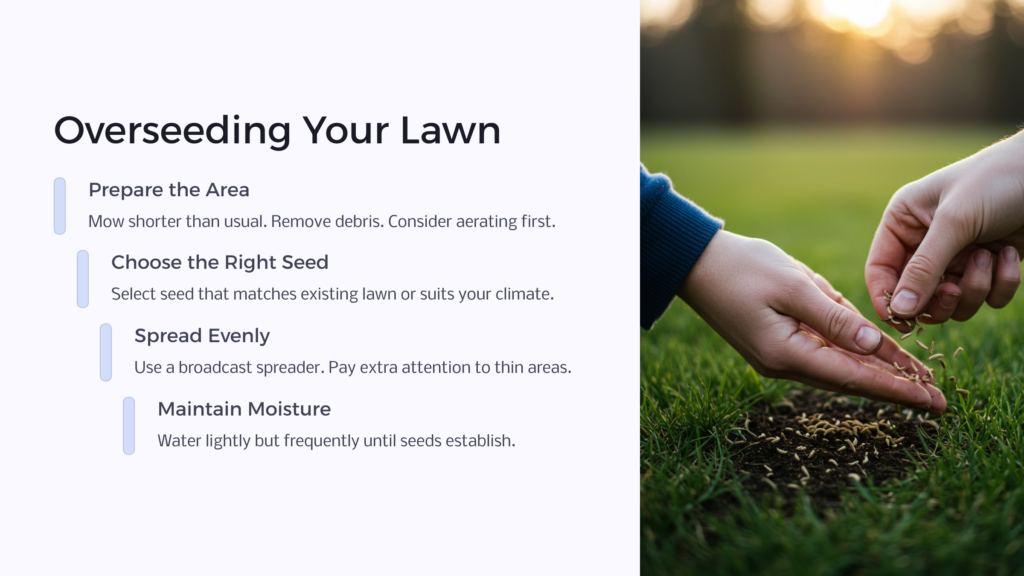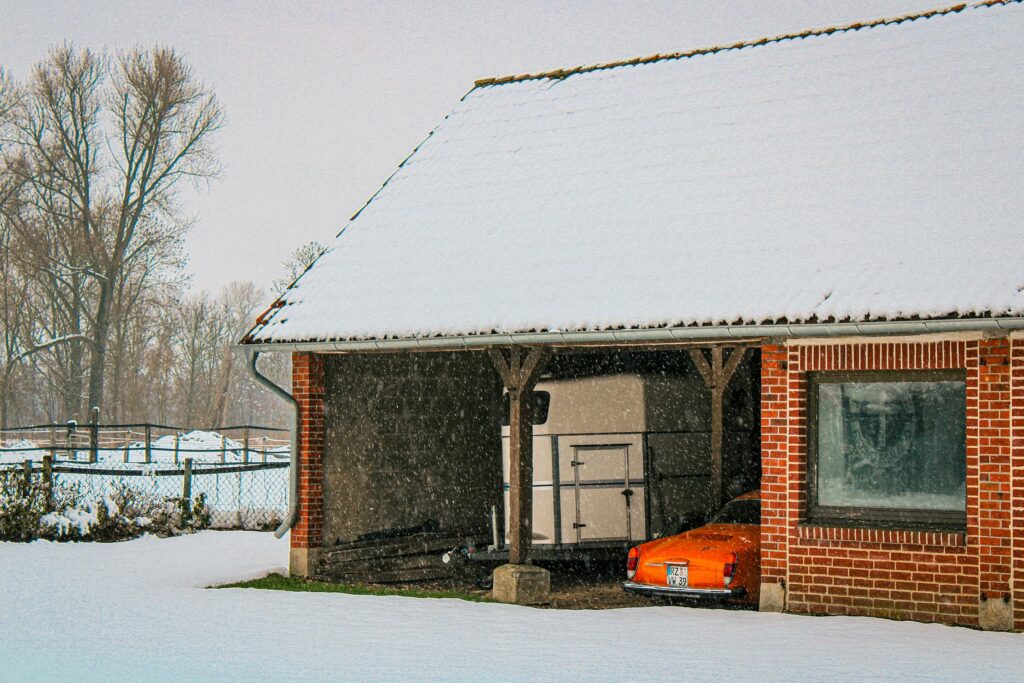As the leaves change color and temperatures start to cool, many homeowners mistakenly believe their lawn care duties are finished for the year. However, fall is actually one of the most crucial seasons for maintaining a healthy, vibrant lawn. Proper fall lawn care sets the stage for a lush, green yard come spring. By taking the right steps now, you can ensure your grass stays strong through winter and emerges ready to thrive when warm weather returns.
Fall lawn care involves a variety of tasks, from mowing and fertilizing to aerating and overseeding. Each of these practices plays an important role in preparing your grass for the challenges of winter and promoting robust growth in the spring. By understanding the key components of fall lawn care and implementing them correctly, you can significantly improve the health and appearance of your yard.
In this comprehensive guide, we’ll explore all aspects of fall lawn care, providing you with the knowledge and tools you need to nurture a beautiful lawn year-round. Whether you’re a seasoned gardener or a first-time homeowner, these tips and techniques will help you achieve the lush, green lawn you’ve always wanted.
Mowing Practices for Fall

As autumn progresses, it’s important to adjust your mowing habits to suit the changing needs of your lawn. While you may be tempted to let your grass grow longer as growth slows down, maintaining a proper mowing height is crucial for fall lawn care.
Continue mowing your lawn regularly throughout the fall, keeping the grass at a height of about 2.5 to 3 inches. This length allows the grass to absorb sunlight efficiently, promoting stronger root growth before winter sets in. However, avoid cutting more than one-third of the grass blade length in a single mowing session, as this can stress the plants.
As you approach the end of the growing season, gradually lower your mower blade. For the final mow of the season, cut the grass slightly shorter than usual, about 2 inches in height. This helps prevent matting under snow cover and reduces the risk of snow mold in colder climates.
Remember to keep your mower blades sharp throughout the fall. Clean cuts heal more quickly and are less likely to invite disease, ensuring your lawn stays healthy as it prepares for winter dormancy.
Fall Fertilization Techniques

Fertilizing your lawn in the fall is one of the most beneficial things you can do to promote healthy growth. As grass growth slows above ground, the plants focus their energy on developing strong root systems. Applying the right fertilizer at this time can provide your lawn with the nutrients it needs to thrive.
Choose a fertilizer with a higher ratio of nitrogen and potassium, often referred to as a “winterizer” fertilizer. These nutrients are crucial for root development and cold hardiness. Aim to apply fertilizer about 2-3 weeks before the ground freezes in your area.
For most cool-season grasses, September is an ideal time for the first fall fertilization. You can follow up with a second application in late October or early November, depending on your local climate. Be sure to water your lawn thoroughly after fertilizing to help the nutrients penetrate the soil.
Avoid over-fertilizing, as this can lead to excessive growth that may be vulnerable to winter damage. Always follow the manufacturer’s instructions for application rates and timing to achieve the best results for your lawn.
Aerating and Dethatching
Fall is an excellent time to aerate and dethatch your lawn, especially if you’ve noticed signs of soil compaction or excessive thatch buildup. These processes help improve soil drainage, reduce thatch, and allow air, water, and nutrients to reach the grass roots more easily.
Aeration involves creating small holes in the soil to alleviate compaction. You can use a manual or mechanical aerator to remove small plugs of soil from your lawn. This is particularly beneficial for heavily trafficked areas or lawns with clay soil. Aerate when the soil is moist but not waterlogged, typically a day or two after rainfall or irrigation.
Dethatching removes the layer of dead grass, roots, and debris that accumulates between the soil surface and the living grass. While some thatch is beneficial, excessive buildup can prevent water and nutrients from reaching the roots. Use a dethatching rake or power dethatcher to remove excess thatch when it exceeds half an inch in thickness.
Perform these tasks early in the fall to give your lawn time to recover before winter. Follow up with overseeding and fertilization to maximize the benefits of aeration and dethatching.
Overseeding in the Fall

Fall is the ideal time to overseed your lawn, especially for cool-season grasses. Overseeding helps fill in bare spots, improve lawn density, and introduce newer, more resilient grass varieties to your yard.
Start by mowing your lawn slightly shorter than usual and remove any debris. If you haven’t already done so, consider aerating before overseeding to improve seed-to-soil contact. Choose a grass seed that matches your existing lawn or opt for a blend that’s well-suited to your climate and lawn conditions.
Spread the seed evenly using a broadcast spreader, paying extra attention to thin or bare areas. Lightly rake the seeded areas to ensure good contact between the seeds and soil. Water the newly seeded lawn lightly and frequently, keeping the top layer of soil consistently moist until the seeds germinate and establish.
For best results, overseed early in the fall, giving the new grass plenty of time to establish before winter. Avoid heavy foot traffic on newly seeded areas and continue to water and mow as needed throughout the fall.
Leaf Management Strategies
As trees shed their leaves in autumn, proper leaf management becomes an essential part of fall lawn care. While a light layer of leaves can be beneficial, allowing thick layers to accumulate can smother your grass and invite disease.
Instead of raking and bagging all your leaves, consider mulching them with your lawn mower. Mulched leaves break down quickly, returning valuable nutrients to the soil. Most modern mowers can handle this task effectively, but you may need to make several passes to chop the leaves finely.
For heavier leaf coverage, raking or using a leaf blower may be necessary. Create leaf piles and either compost them or use them as mulch in garden beds. Some municipalities offer leaf collection services, providing an eco-friendly disposal option.
Remember to clear leaves from your lawn regularly throughout the fall. Waiting until all the leaves have fallen can make the job more challenging and may damage your grass if left too long.
Weed Control in Autumn
Fall is an excellent time to tackle weed control in your lawn. As weeds prepare for winter, they’re more susceptible to herbicides, making your efforts more effective.
Identify the types of weeds in your lawn and choose an appropriate herbicide. For broadleaf weeds like dandelions and clover, a selective herbicide that won’t harm grass is ideal. Apply the herbicide on a calm day when no rain is forecasted for at least 24 hours.
For persistent perennial weeds, consider spot-treating with a non-selective herbicide. Be cautious with these products, as they will kill any plant they contact, including grass.
In addition to chemical controls, maintaining a thick, healthy lawn through proper mowing, fertilization, and overseeding can naturally suppress weed growth. Pull any weeds you see by hand, ensuring you remove the entire root system.
Remember that fall weed control efforts can significantly reduce weed populations in the spring, giving your lawn a head start on the growing season.
Irrigation Adjustments for Fall
As temperatures cool and rainfall often increases in fall, it’s important to adjust your irrigation practices. Overwatering in autumn can lead to fungal diseases and shallow root growth, while underwatering can leave your lawn stressed as it enters winter dormancy.
Monitor rainfall and reduce your watering frequency accordingly. Most lawns need about 1 inch of water per week, including rainfall. Use a rain gauge or place a small container on your lawn to measure water accumulation.
Water deeply but less frequently to encourage deep root growth. Early morning is the best time to water, allowing the grass to dry before evening and reducing the risk of fungal diseases.
As you approach the end of the growing season, gradually reduce watering frequency. However, don’t stop watering entirely until the ground freezes. A final deep watering before winter can help protect grass roots from winter desiccation.
Preparing Your Lawn for Winter

As fall progresses, it’s time to start thinking about winterizing your lawn. This process helps protect your grass from harsh winter conditions and sets the stage for healthy spring growth.
Continue mowing your lawn until growth stops completely, usually after the first frost. For the final mow, cut the grass slightly shorter than usual to prevent matting and snow mold.
Apply a final dose of fertilizer late in the fall, about 2-3 weeks before the ground typically freezes in your area. This late-season fertilization provides nutrients that the grass will store in its roots over winter.
Clean up any remaining leaves, twigs, or debris from your lawn. These can create dead spots if left under snow cover all winter. Consider applying a layer of compost to nourish the soil and protect grass roots.
Finally, prepare your lawn care equipment for storage. Clean and sharpen mower blades, empty gas tanks or add fuel stabilizer, and store equipment in a dry place. Taking these steps now will ensure you’re ready to hit the ground running when spring arrives.
By following these fall lawn care practices, you’ll be well on your way to maintaining a healthy, vibrant lawn year-round. Remember, the effort you put into your lawn this fall will pay dividends in the beauty and health of your yard next spring and summer.



